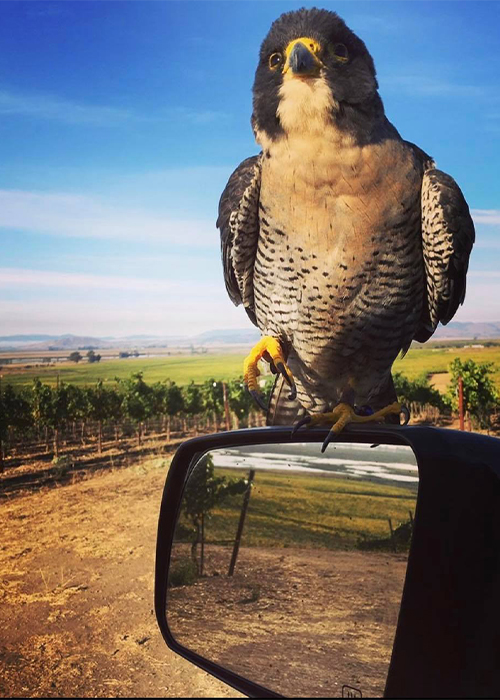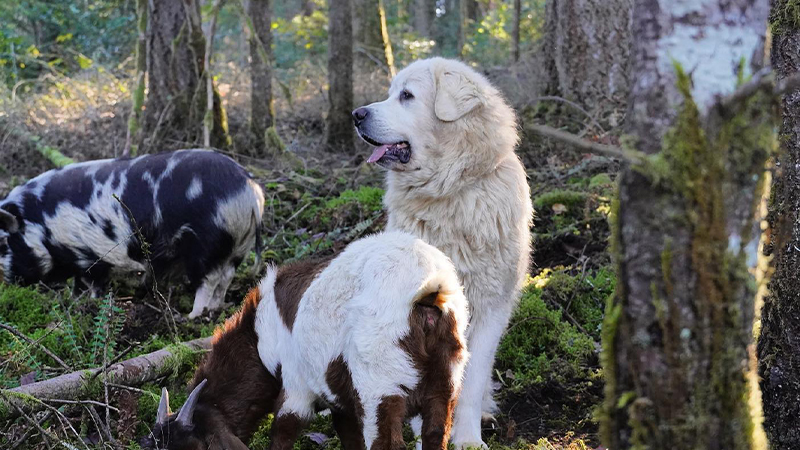Most grape growers want to be good stewards of the land that they farm while minimizing their impact on the environment. For many, this means limiting the use of pesticides and herbicides, conserving water, and composting, while others are thinking outside the box. Below are a few of the creative ways that winemakers are doing what’s best for the planet while boosting their businesses in the process.
Welcoming Birds
Birds can be a blessing and a curse to vintners. During harvest, Diora Wines, located in King City, Calif., partners with two falconers who bring in their expertly trained raptors to remove grape-eating birds from the vines.
To keep the gopher and vole populations down naturally — these rodents chew through vines’ root systems, which cuts off access to nutrients and water and can ultimately kill the plants — the winery has also installed nearly 80 owl boxes throughout the property.
Don’t miss a drop!
Get the latest in beer, wine, and cocktail culture sent straight to your inbox.
“If you walk through our vineyards, you’ll see piles of bones underneath our nesting boxes — and they accumulate rapidly,” says Diora’s winemaker, James Ewart. “It’s amazing how much [the owls] eat.”
Napa’s Bouchaine Vineyards also works with falconers, and visitors can learn about and see the birds during the winery’s Falconry in the Garden programming. Meanwhile, barn owls that nest in owl boxes at La Mesa Vineyards in Plymouth, Calif., each eat upwards of five gophers and voles a day. The winery leaves rattlesnakes and king snakes alone so that they, too, can help with natural pest management.

Promoting Pollinators
Although grapes can self-pollinate, many winemakers are creating vineyard habitats for natural pollinators like bees and butterflies to thrive. This practice encourages biodiversity, which, in turn, helps create a thriving overall ecosystem, healthier grapes, and a bucolic backdrop for those visiting the winery.
Through a partnership with Pollinator.org, staff at Jordan Vineyard & Winery have planted more than 5,000 plants — many of them native to the region — on the 1,200-acre ranch in Healdsburg, Calif., to help increase monarch butterfly and bee populations. Meanwhile, Oakville’s Gamble Family Vineyards has bee hives throughout its 175 acres, and is creating living hedge vineyard borders to provide habitats for birds and beneficial bugs.
At Bitner Vineyards in Caldwell, Idaho, entomologist Ron Bitner plants rotating crops between the vineyard rows just for bees. To ensure he has something blooming year-round for different species, he grows mustard in the spring, red and crimson clover in the middle of the summer, and sunflowers in the fall.
Crushing Glass
When the local recycling company suspended services and new Covid-19 sanitation protocols meant the winery was producing more packaging and waste than ever before, the trash and recycling bins at Virginia’s Afton Mountain Vineyards began to overflow. “Our team’s desire to be as environmentally friendly as possible was being pushed aside,” says co-owner Elizabeth Smith.
Now, the winery crushes bottles used for tastings and other on-site drinking to a sand-like consistency, then spreads the material below the vines. This helps keep weeds and other volunteer plants at bay while also helping to loosen the region’s hard-packed soils, says Smith.
Animals Abound
Wineries are turning to sheep, goats, pigs, poultry, and other barnyard animals to help “mow” down grass and cover crops, spread free fertilizer among the vines, eat bugs and rodents, and help prevent wildfires.
Oregon’s Antiquum Farm has an entire crew of animals on staff to help with its grazing-based viticulture, including Katahdin/Dorper sheep, Kunekune pigs, geese, chickens, ducks, and guardian dogs. Sonoma’s Cline Cellars has more than 500 goats and 1,500 sheep roaming its vineyards, while Paso Robles’ Tablas Creek Vineyard keeps sheep, alpacas, donkeys, and hives of bees on the property to help support its biodynamic farming practices.

Worm Work
Below the ground, worms help break down organic matter, decrease water runoff, and aerate the soil. But the team at Abbott Claim in Carlton, Ore., is also putting these critters to work above ground with a wine wastewater filtration system powered entirely by worms.
The system, designed by the Chilean company Biofiltro and housed at the winery in a shipping container, removes up to 99 percent of contaminants within just four hours. Abbott Claim then safely releases its worm-filtered water into an on-site pond. “Winery effluent tends to be too acidic and loaded in nitrogen and organic matter, so releasing it untreated would have a negative effect on the environment,” says head winemaker Albain Debeaulieu.
Sumac Solution
Four years ago, Bashakill Vineyards in Wurtsboro, N.Y., had a sumac problem — and a big one, at that. The invasive flowering shrub grew all over the winery’s four-acre property in the Bashakill Wetlands and, because of its interconnected root system, was almost impossible to dig up and eradicate.
Eventually, owner Samara Ferris decided on an “If you can’t beat ‘em, join ‘em,” approach and began making sumac wine from the stubborn plant. Her team harvests the sumac in August, bottles the 6 percent ABV beverage throughout the winter, and serves it during the following summer. Ferris says that it tastes a bit like raspberry tea.
“We try to use things that are in season around the winery, and we try not to fight the natural elements. It has taken us down some really interesting turns,” says Ferris. “It’s fun to be given a problem where you have to find a creative solution in a sustainable way.”


